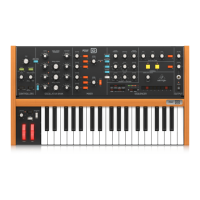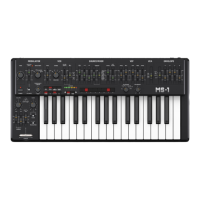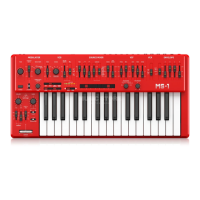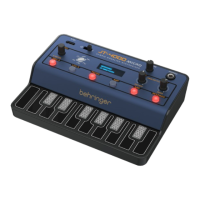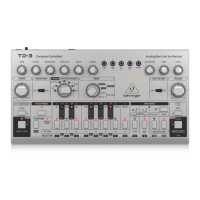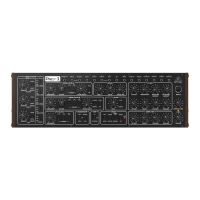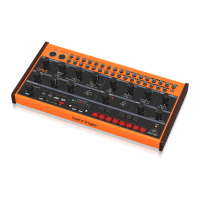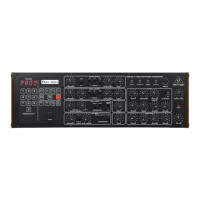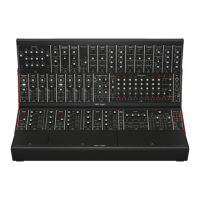38 MODEL D User Manual
Monitors: Studio quality loudspeakers, providing an accurate representation of
the audio signals.
Mono: A single signal.
Monophonic: Only one note can be played at any given time, as there is only a
single voice.
Mute: Function that allows a signal to be silenced.
N/A: Abbreviation for "not applicable" or "not available".
Noise Generator: A circuit or process that produces a random (or aperiodic)
signal. The frequency response can dier depending on the type of noise.
Note-Priority: Determines which note is played when more notes are held
simultaneously than the number of available voices (often: low/high/last).
Octave or Oct: Unit of measurement for pitch. Every time the frequency of a
waveform doubles, the pitch increases by one octave.
Ohm (Ω): Unit of electrical resistance.
Oscillator: An electronic device which generates a periodic signal used to form
the basis of a synthesizer program.
One Shot: A single event that has to be triggered each it is required.
Output: The signal sent out by a device or process. Also used to describe the
physical socket where a signal leaves a device.
Overtone: Any frequency that is present in a waveform that is higher than the
fundamental frequency of that waveform.
Pad: A program that is usually characterized by slow attack and release times.
Panning / Pan: The positioning of a signal within a stereo image.
Parameter: A setting whose value can be changed.
Parametric EQ: A type of EQ that allows all of the parameters of equalisation to
be changed, including centre frequency, boost/cut in gain and bandwidth.
Partial: Any of the sinusoidal waveforms which form part of a complex tone.
Patch: The cables used on modular synthesizers (or synthesizers with modular
compatibility) to connect devices together. Patch cables can carry audio, gate or
control voltage signals.
Period: The time that it takes a wave to complete a full cycle. Period is calculated
by dividing 1 by the frequency
Phase: A measurement (in degrees) of the time dierence between two
waveforms, or between a single waveform and a reference point.
Phaser: An eect which uses a series of notched all-pass lters (also called
stages) to create a comb-lter response which does not always have harmonic
relationships between the notches. The result is a sweeping eect similar to a
anger but smoother and often more natural sounding.
Pink Noise: A type of signal that has equal power in each band. Human hearing
is roughly logarithmic, therefore each octave is discerned to have an equal
amount of power across the audible spectrum.
Pitch: A quality of sound that makes it possible to judge if a sound is higher or
lower than another.
Pitch Bend / Pitch Bend Wheel: Controlling the pitch of a note after it has
been played.
Pitch Shift: Alteration of pitch or frequency, but without adjusting tempo.
Pole: A section of a lter stage. The more poles a lter has, the steeper its
attenuation slope will be, and the more accurate the lter will be.
Polyphonic: Capable of playing more than one note at once.
Polyphony: The number of notes a polyphonic synthesizer can play
simultaneously.
Portamento: An adjustable performance eect that glides or bends the pitch
from one note to the next.
Post: The point for accessing audio just after it leaves a specic component or
stage. For example Post-Fader audio is aected by the fader.
Pre: The point for accessing audio just before it reaches a specic component or
stage. For example, Pre-Fader audio is not aected by the fader.
Preset: A program or part of a program that is built into synthesizer patches that
are sometimes xed and sometimes editable.
Program: A complete set of parameters and settings which the synthesizer uses
to create a specic sound.
Power Supply Unit (PSU): The component in a system which is responsible for
supplying and managing power.
Psychoacoustics: The study of the perception of sound, that is, how we
listen, our psychological responses, and the physiological eects on the human
nervoussystem.
Pulse Wave: Similar to a square wave, but without symmetry. Also known as a
"Rectangle Wave."
Pulse Width Modulation (PWM): Modulation of the pulse width (the duty
cycle of a pulse wave measured as a percentage). A pulse width of 50% has equal
positive and negative sections and is considered a square wave.
Q Factor: A bandwidth (or selectivity), of a particular band in an equalizer. The
higher the Q Factor, the wider the bandwidth.
Rate: The speed at which a particular device is operating.
Release Time: The fourth and nal stage of an ADSR envelope. Specied as the
duration of time for an envelope to reach zero after the played key is released.
Resonance: The emphasis/boost of frequencies around the cut-o point just
before attenuation starts to occur. As resonance increases, it will reach a point
where the lter will start to self oscillate, producing a signal even when there is
no input.
Reverb: An eect where the ambience of a physical space is simulated.
s: Symbol for "second," a unit of time.
Sample Rate: The number of digital samples used every second to represent an
analog waveform.
Sample Resolution (Bit Depth): The number of digital bits used to dene
the amplitude of an analog signal. Higher resolution results in greater
dynamic range.
Sawtooth: A waveform that combines an instantaneous rise or fall, followed
by a gradual linear incline or decline. The name comes from the waveform's
similarity to the teeth of a saw.
Semitone: A chromatic half-step. There are twelve semitones in an octave.
Sequencer: A programmable device or module used to arrange/sequence timed
events into musical patterns and songs.
Self-oscillation: Occurs when the resonance of a lter is increased to the point
where it will begin to generate a sine wave independently of any input.
Signal ow: The path of a signal from one module (or component of a system)
to another.
Sinusoidal / Sine Wave: Mathematical description of a smooth waveform that
contains only the fundamental frequency and has no additional harmonics. The
shape resembles the letter "S" rotated 90 degrees.

